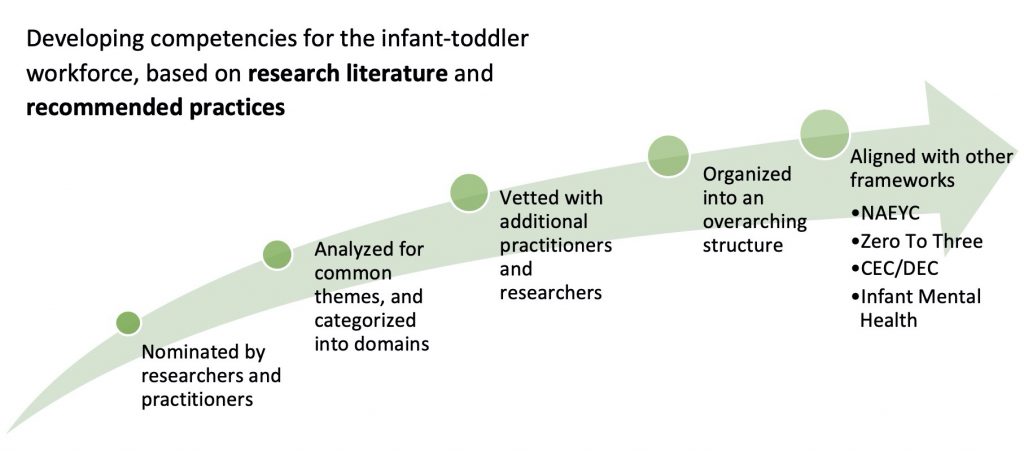CUPID developed a set of comprehensive competencies based on knowledge of the research and standards of practice in the field. The total set of 173 competencies, organized into 9 dimensions, reflect the full set of knowledge, dispositions, and skills that practitioners need to operate as a professional in infant/toddler care and education. In addition, CUPID has articulated the Facilitating Conditions – the workplace supports – that infant/toddler practitioners need in order to fully utilize their competencies to implement the highest quality practices with babies and their families.
| RFP | Reflective Practice (16 competencies) | Carefully observing, and pausing to think about what we see and experience in order to respond with intention, and to changes practices. This includes reflecting on the underlying meaning of others’ behavior; on how our own experiences, thoughts, and feelings affect our understandings of others’ behavior; and how our actions affect others. |
| REL | Building & Supporting Relationships (18 competencies) | Engaging in warm and responsive interactions with babies, families, and colleagues to foster a positive network of relationships over time. Creating opportunities for babies and families to contribute to reciprocal relationships. |
| FAM | Partnering with and Supporting Diverse Families (23 competencies) | Establishing effective, regular, bi-directional communication with families to guide practices that synthesize family and professional perspectives, and that work towards shared goals for the baby. |
| GDB | Guiding Infant/Toddler Behavior (22 competencies) | Helping babies meet behavioral expectations appropriate to their developmental level in ways that reinforce a positive relationship with the baby, and support their development of autonomy and regulation. |
| DVL | Supporting Development & Learning (21 competencies) | Engaging in an ongoing cyclical process to support babies’ development and learning across domains by (a) structuring the physical and relational environment and daily routines to promote engagement, exploration, and communication, (b) individualizing interactions to be responsive to and support babies’ interests, needs, and developing skills, and (c) planning and implementing intentional and flexible learning opportunities. |
| ABD | Assessing Behavior, Development, & Environments (19 competencies) | Observing, screening, and assessing babies, families, and learning environments in order to adapt and individualize goals and practices, including supporting children’s unique needs and identities. |
| INC | Including Infants & Toddlers with Special Needs (16 competencies) | Using strength-based, family-centered, and collaborative practices to support babies with special needs, guided by requirements of IDEA Part C, including working with families and other professionals to identify and implement the best supports for babies. |
| PRO | Professionalism (19 competencies) | Engaging in the broader profession by articulating the importance of work with babies and families, maintaining professional ethics and legal requirements, and seeking out and applying evidence-based practices and standards in one’s work. |
| LED | Leadership, Mentoring, & Coaching (19 competencies) | Supporting adult learners (e.g., parents, colleagues) to develop competencies themselves, and their sense of efficacy needed to support babies’ development. |
The figure below expresses a conceptual relationship between the nine dimensions of the CUPID competencies. This figure and framework can be used for developing, aligning, and sequencing coursework and trainings for infant/toddler pre-service and in-service practitioners.

These competencies were developed through a multi-step process depicted below. What is unique about the CUPID competencies is that they are focused on the needs of the practitioners who work specifically with infants and toddlers, and they are comprehensive in nature. While most other competency frameworks articulate the skills that could be assessed through observation of educators’ direct interactions with children, the CUPID competencies consider the many complex sets of knowledge, skills, and dispositions that are needed by a professional both in interactions with children and families and in other aspects of their work.

The full set of CUPID Competencies for Educators of Infants and Toddlers has been published in the following article:
Vallotton, C. D., Peterson, C., Chazan-Cohen, R., Cook, G., Brophy-Herb, H., & Ispa, J. (2019). Comprehensive Competencies for Infant/ Toddler Educators. In M. A. Peters (Ed.) Encyclopedia of Teacher Education. New York, NY: Springer https://link.springer.com/referenceworkentry/10.1007%2F978-981-13-1179-6_69-1
The Zero To Three critical competencies for Infant Toddler Educators are aligned the 2015 version of the CUPID competencies:
The competencies for infant/toddler educators are relevant for home visitors as well as classroom- or group-care practitioners. Read about this extension of the competencies for the home-visiting workforce here:
Roggman, L., Petersen, C., Chazan-Cohen, R., Ispa, J., Decker, K., Cook, G., Hughes Belding, K., & Vallotton, C. D. (2016). Preparing home visitors to partner with families of infants and toddlers. Journal of Early Childhood Teacher Education, 37(4), 301-313. DOI: http://dx.doi.org/10.1080/10901027.2016.1241965
https://www.tandfonline.com/doi/full/10.1080/10901027.2016.1241965
The CUPID competencies have also been used to align standards with certification for home visitors, described in the following:
Walsh, B. A., Mortensen, J. A., Peterson, C. A., Cassidy, D., & CUPID (2019). Competency alignment and certification for preservice home visitors. Family Relations 2019, 1-12. Doi: 10.1111/fare.12414